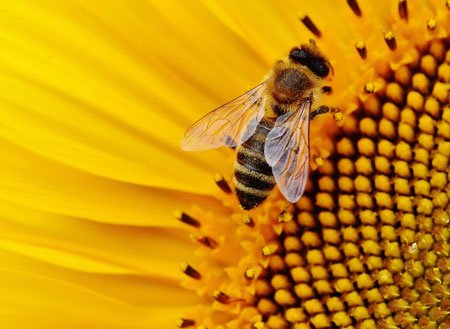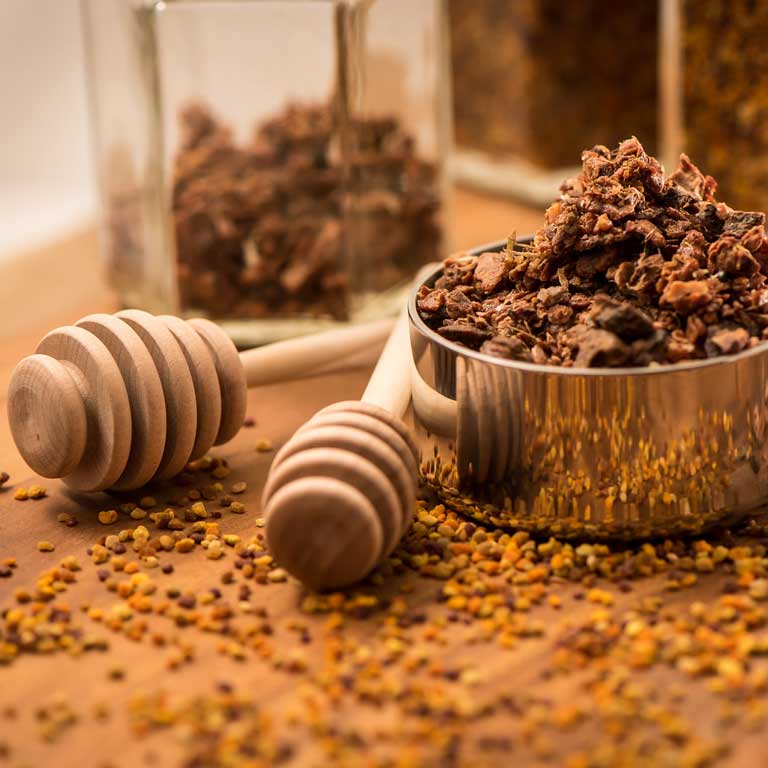
Propolis. Characteristics and Benefits
What is propolis?
The word propolis or propolis comes from the Greek, "Pro" meaning "in front of" or "at the entrance of" and "polis" meaning "community" or "city", which means a substance that is used to preserve the hive. It is a waxy resin, complex in composition and viscous in consistency, which bees make and use in the construction, repair, insulation and preservation of the hive.
Importance of propolis in hives
Propolis is also called "bee glue", which is a natural resinous (wax-like) substance found in beehives and is used by bees as a cementing material to close open spaces and cracks in their hives. It is also used for its "cleansing or antiseptic" effect to protect the bee larvae, honey stores and comb. Likewise, propolis prevents water from getting into the hive, which keeps the humidity constant and also helps to control the flow of air into the hive.
How bees produce propolis
 Propolis, or propolis, is collected by worker bees from many plant resinous secretions, such as mucilages, gums, resins and lattices, and also from the leaf buds of different plant species such as palm, pine, alder, poplar, beech, conifer and birch, and is then mixed with salivary and enzymatic secretions.
Propolis, or propolis, is collected by worker bees from many plant resinous secretions, such as mucilages, gums, resins and lattices, and also from the leaf buds of different plant species such as palm, pine, alder, poplar, beech, conifer and birch, and is then mixed with salivary and enzymatic secretions.
Composition of propolis
Propolis is mainly composed of resin (50%), wax (30%), essential oils (10%), pollen (5%) and other organic compounds (5%). Phenolic compounds, flavonoids, terpenes, among others, are the main organic compounds present in propolis.
Twelve different flavonoids have been found in propolis extracts, including pinocembrin, kaempferol, apigenin, catechin, naringenin, galangin and quercetin; two phenolic acids, caffeic acid and cinnamic acid; and a stilbene derivative called resveratrol.
What is galangin, one of the most important bioactives
Galangin is one of the most important bioactives in propolis, so it is a symbol of quality and nutritional value that should always be checked when ingested.
Make sure that the products you consume contain at least 10% high-purity galangin.
Propolis also contains important vitamins, such as vitamins B1, B2, B6, C and E, and useful minerals such as magnesium, calcium, potassium, sodium, copper, zinc, manganese and iron. Some enzymes, such as succinic dehydrogenase, glucose-6-phosphatase, adenosine triphosphatase and acid phosphatase, are also present in propolis.
Use of propolis
There is a long history of traditional uses of propolis. The Egyptians recognised its properties for embalming corpses. In Greece and Rome, it was used as a natural wound cleanser and repairer and as a mouth disinfectant.
In the last few decades, propolis has become increasingly popular as a health food in many parts of the world, including the United States, Japan and the European Union, where it has become a priority food for human well-being.
It is found commercially in a wide range of ways. From tablets, capsules, or cough syrups containing propolis, to soaps, creams, gels, skin lotions, or even toothpastes, mouthwashes, shampoos, or antiseptic mixtures. In food we can find it in propolis candies, chewing gum, wine, cakes, chocolate bars, and it is also used to preserve meat.
What are the uses of propolis?
In the food industry, it is used in many preparations for its nutritional value and its use in food preservation technology. It is also widely used in pharmaceuticals, both as an additive and in synergy with some therapeutic preparations.
Dermatological and cosmetic applications are other common uses of propolis and its extracts. Its effects on tissue regeneration and renewal have been well studied, providing many benefits in several cosmetic applications.
Benefits of propolis
The long-standing use of propolis has shown its benefits both through in vitro studies to test its effects, as well as through ingestion and topical application in humans. Here are some of them:
- In vitro studies have proven that it has antioxidant activity, due to the presence of flavonoid ingredients of plant origin that are contained within propolis.
- Propolis has shown benefits in restricting the development of periodontitis-causing bacterial plaque due to its "natural cleansing" effects. Propolis extracts are also very useful in halitosis, a disorder in which the person suffers from unpleasant breath, mainly due to poor oral hygiene.
- Propolis is widely used in dermatological products such as creams and ointments. Its use in skin care products is based on its effects on skin regeneration and repair, with excellent skin tolerability. Several studies have suggested that these activities are due to its antioxidant effect.
- It has been used in different herbal pharmaceutical preparations, combined with Echinacea, Honey or Royal Jelly, for respiratory disorders.
How to take propolis?
 As we have seen, propolis can be taken in different preparations (capsules, oral-liquid vials, etc.), as well as applied in creams, ointments or other topical formulations.
As we have seen, propolis can be taken in different preparations (capsules, oral-liquid vials, etc.), as well as applied in creams, ointments or other topical formulations.
Recommended amount of propolis
Propolis has shown a good safety profile, in fact, the Spanish Agency for Consumer Affairs, Food Safety and Nutrition does not set maximum consumption limits for this ingredient.
How much propolis can I take?
It is important to note that chewing large amounts of raw propolis can cause nausea and digestive disorders.
Also, as it is a bee-derived product, it is important to check if there is any special sensitivity to bee products (pollen, honey, etc.) before taking it.
Propolis as a food supplement
Propolis, also called propolis, is widely used as a food supplement because of its many and varied benefits.
Before taking propolis supplements, it is important to validate its components with a correct evaluation of its quality. To do this, it is necessary to look at a number of official parameters such as:
- To be free of toxic contaminants.
- Contain low percentages of wax, insoluble matter and ash.
- Define its botanical origin to determine the kind of active compounds.
- To have a high content of active ingredients.
Therefore, to assess the quality of propolis, a visual inspection of its physical and organoleptic characteristics (appearance, consistency, taste, origin, colour or smell) should be carried out.
Royal jelly with propolis
Propolis and royal jelly, two important products of honey bees, have been commonly used worldwide as traditional nutrients since ancient times. Both have a large amount of active ingredients that are known to be efficient for food welfare in both humans and animals.
Compared to propolis, royal jelly has been found to be richer in the three main nutrients: proteins, carbohydrates and lipids.
Royal jelly is a yellowish-white, creamy, acidic secretion mixture produced by worker bees through their mandibular and hypopharyngeal glands to supply a major food source to the queen bee, which is the coloniser of the hive. It is a nutritive secretion rich in minerals, vitamins, carbohydrates and proteins. It has many minerals (mainly calcium and iron), vitamins (mainly riboflavin, niacin, thiamine), fatty acids, sugars, proteins and free amino acids.
Propolis and echinacea
There are products containing ingredients such as echinacea that can help the immune system function. It is sometimes found in such products along with other ingredients such as propolis.
The benefits of echinacea include its usefulness for the normal functioning of the respiratory system, as registered within the monographs of the EMA, the German Commission E and EFSA ON HOLD (3950, 4032, 3342), as well as contributing to the maintenance of normal immune function (EFSA ON HOLD 2366).
Propolis is also a powerful ally for our well-being, as it is a substance that the bees themselves use to seal the walls and cells of the hive and thus protect the honeycomb.





